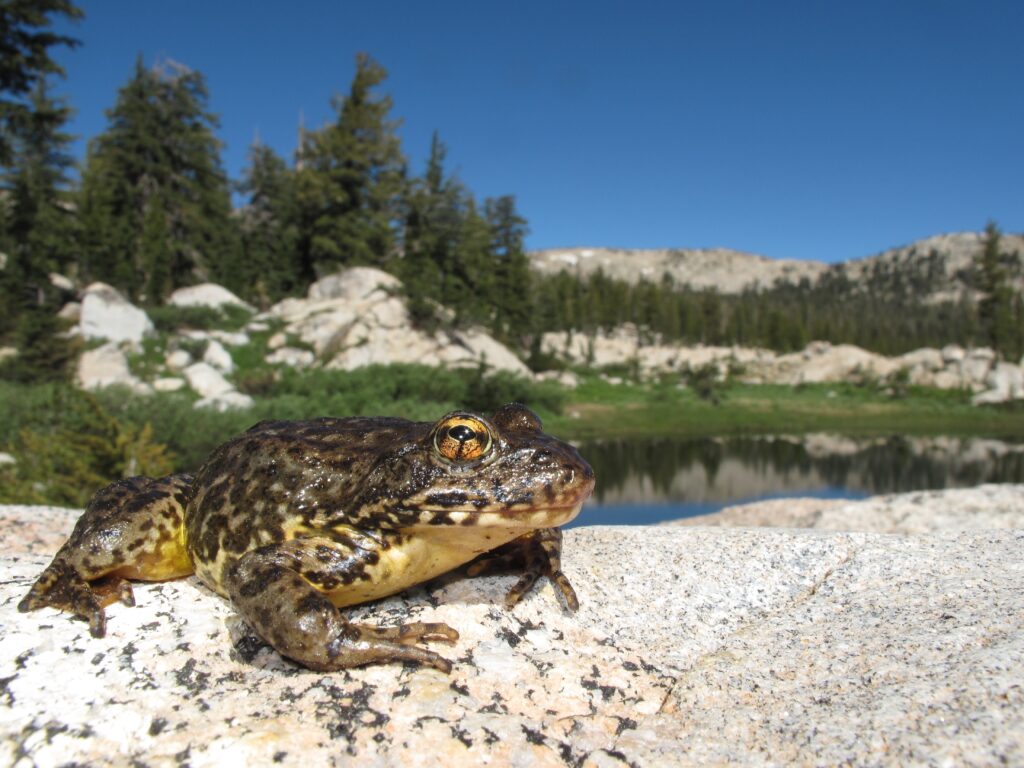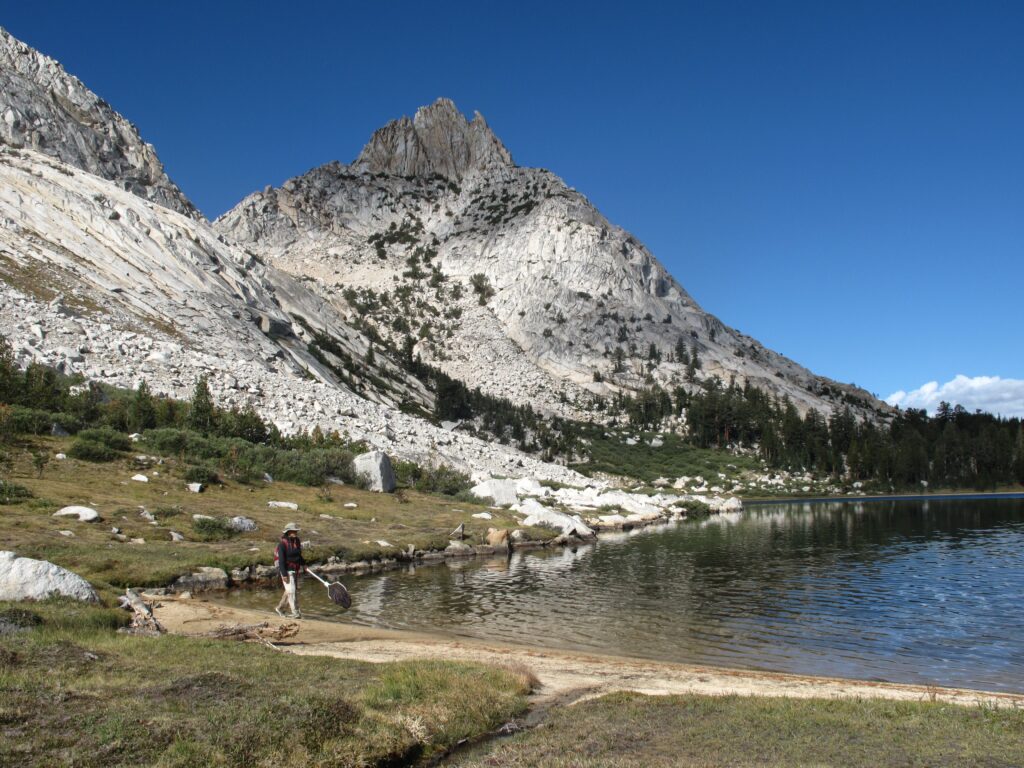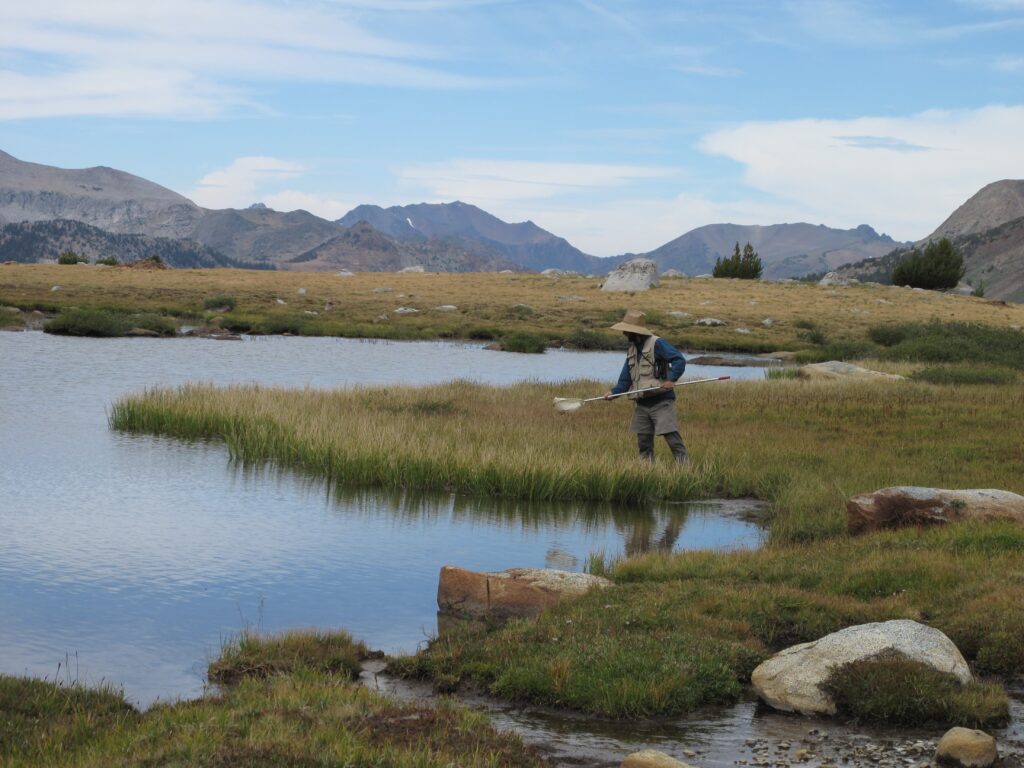By Erica Leiserowitz
Over a century ago, the Sierra Nevada yellow-legged frog (Rana sierrae) was abundant throughout the watersheds of the Sierra Nevada mountains, located on the East side of California. But soon, this frog’s life took a dramatic turn. With the increase of humans living in the area, and more and more visitors to Yosemite National Park, the landscape began to change. There was more development, more pollution, and some of their habitat was destroyed due to construction and pollution. Perhaps most damaging was the decision to stock naturally fishless habitats with nonnative fish (usually trout) so that anglers could fish for recreation. Those fish predate on tadpoles of native amphibians, including R. sierrae, which did not evolve with fish as predators. Then, in the 1970’s, Bd (Batrachochytrium dendrobatidis), a fungal pathogen that causes Chytridiomycosis, a very devastating and lethal infectious disease, emerged in the Sierra Nevadas. All of these factors, and possibly more, led to R. sierrae disappearing from >93% of its historical distribution. This story is, unfortunately, not a rare one, and is shared by many amphibian species around the world. But this is where the Sierra Nevada yellow-legged frog’s story becomes unique. Despite the presences of disease, new predators, habitat loss, and more, the R. sierrae is showing signs of recovery.

In a scientific article published in 2016, researchers studying R. sierrae in Yosemite have found data that shines a ray of hope on the world of amphibian conservation. The article is called “Large-scale recovery of an endangered amphibian despite ongoing exposure to multiple stressors.” Over a 20 year study period surveying the total population of R. sierrae, they determined that the population increased by an average of 11% annually, which is a more than sevenfold increase in abundance over 20 years. These surveys involve researchers and technicians hiking and backpacking all over Yosemite to get to various ponds and lakes, no matter how remote. At the sites, they walk around the edges of the pond, count what they see, and take notes. These population counts are compared to previous years, and allows researchers to notice trends in population size, but also how many individuals were infected with Bd, or how many frogs are at one pond compared to another. I interviewed one of the authors of this article, US Geological Survey Ecologist Patrick Kleeman. His research focuses on amphibians in Yosemite and the surrounding areas, and the results of this study were as much as a surprise to him as they were to me.
“It gives me a sense of hope!”
He explained to me that from a personal level, it is not just exciting, but also very gratifying. It shows that there is a chance for recovery for endangered species, and that protection policies have an impact.

It is unclear why the R. sierrae population is increasing. It might be because the National Park Service (NPS) stopped introducing trout into the watershed, and the number of fishless lakes increased. It also might be that R. sierrae is becoming resistant to Bd, due to Bd’s now long-term presence in the area. Because there are so many factors causing declines, it is often hard to pinpoint exactly what is causing an increase.
Patrick Kleeman says that this is why keeping up long-term surveys is so important.
“We might not have noticed this trend if we hadn’t been conducting large scale surveys in Yosemite since 1993. It allows you to compare your data to the previous years, and notice changes or patterns in population.”

I asked Kleeman why the public should care about this increase in R. sierra. He explained that even though frogs like R. sierrae may not be the most charismatic animals, they are still important. Even people who don’t like frogs should pay attention to global amphibian declines. Amphibians like R. sierra are important parts of the ecosystem. They prey on organisms and in turn are prey for other animals. Their presence is woven into the food web. Amphibians have also benefitted humans directly, as they have been used in medical research. While there are increases in R. sierrae in Yosemite, complete recovery is still a long way off, so the policies used to protect this species, like preventing dumping pollutants into watersheds, or preventing stocking fish into naturally fishless areas still need to remain in place. In the meantime, we are still cheering for the Sierra Nevada yellow-legged frog, and hope that other amphibians will also take their lead.
